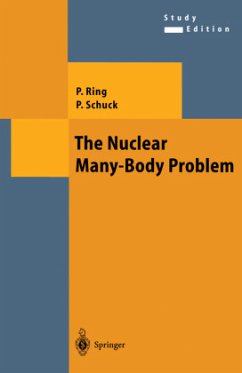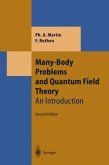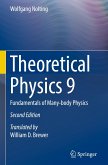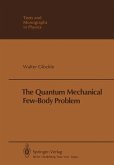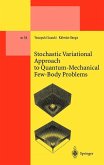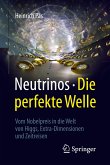This long-standing introductory text thoroughly describes nuclear many-body theory, with an emphasis on methodology and the technical aspects of the theories that have been used to describe the nucleus. Now available in a more affordable softcover edition, the original contents of The Nuclear Many-Body Problem presented here is intended for students with basic knowledge of quantum mechanics and some understanding of nuclear phenomena.
From the reviews:"Its scope and complexity are suitable for easy reading by beginning students of nuclear theory. With a crisp and concise style, the authors quickly develop the shell-model approach to the nuclear many-body problem and subsequently devote more than a third of the text to Hartree-Fock and related models..." Physics Today
It is the aim of this book to describe in concise form our present theoretical understanding of the nuclear many-body problem. The presen tation of the enormous amount of material that has accumulated in this field over the last few decades may be divided into two broad categories: One can either concentrate on the physical phenomena, such as the single-particle excitations, rotations, vibrations, or large-amplitude collec tive motion, and treat each of them using a variety of theoretical methods; or one may stress the methodology and technical aspects of the different theories that have been used to describe the nucleus. We have chosen the second avenue. The structure of this book is thus dictated by the different methods used-Hartree-Fock theory, time-dependent Hartree-Fock the ory, generator coordinates, boson expansions, etc. -rather than by the physical subjects. Many of the present theories have, of course, already been presented in other textbooks. In order to be able to give a more rounded picture, we shall either briefly review such topics (as in the case of the liquid drop or the shell model) or try to give more updated versions (as in the cases of rotations or the random phase approximation). Our essential aim, however, is to present the more modern theories-such as boson expansions, genera tor coordinates, time-dependent Hartree-Fock, semiclassical theories, etc. -which have either never been seen, or at best had little detailed treat ment in, book form.
From the reviews:"Its scope and complexity are suitable for easy reading by beginning students of nuclear theory. With a crisp and concise style, the authors quickly develop the shell-model approach to the nuclear many-body problem and subsequently devote more than a third of the text to Hartree-Fock and related models..." Physics Today
It is the aim of this book to describe in concise form our present theoretical understanding of the nuclear many-body problem. The presen tation of the enormous amount of material that has accumulated in this field over the last few decades may be divided into two broad categories: One can either concentrate on the physical phenomena, such as the single-particle excitations, rotations, vibrations, or large-amplitude collec tive motion, and treat each of them using a variety of theoretical methods; or one may stress the methodology and technical aspects of the different theories that have been used to describe the nucleus. We have chosen the second avenue. The structure of this book is thus dictated by the different methods used-Hartree-Fock theory, time-dependent Hartree-Fock the ory, generator coordinates, boson expansions, etc. -rather than by the physical subjects. Many of the present theories have, of course, already been presented in other textbooks. In order to be able to give a more rounded picture, we shall either briefly review such topics (as in the case of the liquid drop or the shell model) or try to give more updated versions (as in the cases of rotations or the random phase approximation). Our essential aim, however, is to present the more modern theories-such as boson expansions, genera tor coordinates, time-dependent Hartree-Fock, semiclassical theories, etc. -which have either never been seen, or at best had little detailed treat ment in, book form.
From the reviews:
"The monography by Peter Ring and Peter Schuck covers the techniques used to solve the nuclear many-body problem ... . is recognized as a reference by the nuclear physics community. Theoretical developments are explained pedagogically, with a constant rigour, are well documented and are illustrated with suitably chosen examples. The book contains a lot of references ... . It is served by a concise style. By its scope and rigour, it has no real rival and will expectedly remain a familiar introductory text in nuclear structure theory for many years." (Joseph Cugnon, Physicalia, Vol. 57 (3), 2005)
"In many ways, the 1950s through to the 1970s may be seen as a golden period for the development of nuclear physics, both experimental and theoretical. ... The book contains an excellent description of many basic theoretical methods, which continue to be relevant today, it is still of value to specialist students of nuclear theory." (J. P. Elliott, Contemporary Physics, Vol. 46 (6), 2005)
"The monography by Peter Ring and Peter Schuck covers the techniques used to solve the nuclear many-body problem ... . is recognized as a reference by the nuclear physics community. Theoretical developments are explained pedagogically, with a constant rigour, are well documented and are illustrated with suitably chosen examples. The book contains a lot of references ... . It is served by a concise style. By its scope and rigour, it has no real rival and will expectedly remain a familiar introductory text in nuclear structure theory for many years." (Joseph Cugnon, Physicalia, Vol. 57 (3), 2005)
"In many ways, the 1950s through to the 1970s may be seen as a golden period for the development of nuclear physics, both experimental and theoretical. ... The book contains an excellent description of many basic theoretical methods, which continue to be relevant today, it is still of value to specialist students of nuclear theory." (J. P. Elliott, Contemporary Physics, Vol. 46 (6), 2005)

